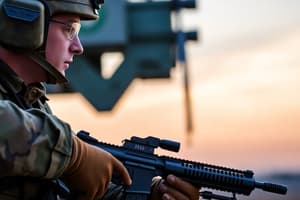Podcast
Questions and Answers
Which of the following accurately represents an aspect of the discursive conception of security?
Which of the following accurately represents an aspect of the discursive conception of security?
- All harmful activities are considered security threats.
- Security threats are always defined by their potential to cause military conflict.
- Only external military threats require national attention.
- Some activities like smoking may harm referent objects but are not classified as security threats. (correct)
What is NOT one of the three analytic tools used by security analysts?
What is NOT one of the three analytic tools used by security analysts?
- Weapons technology analysis (correct)
- Security sectors
- Referent object of security
- Conception of security
Which sector is classified as part of the broader framework of security sectors?
Which sector is classified as part of the broader framework of security sectors?
- Transportation sector
- Cultural sector
- Agricultural sector
- Environmental sector (correct)
What defines military security in a state?
What defines military security in a state?
How do states typically respond to military threats?
How do states typically respond to military threats?
What primarily distinguishes the geopolitical study?
What primarily distinguishes the geopolitical study?
Which of the following examples represents an internal military threat?
Which of the following examples represents an internal military threat?
What is the primary role of a state’s naval, air, and land forces?
What is the primary role of a state’s naval, air, and land forces?
What is the primary objective of an attrition strategy in military terms?
What is the primary objective of an attrition strategy in military terms?
How does the coercion strategy aim to influence an adversary?
How does the coercion strategy aim to influence an adversary?
Which military strategy emphasizes knocking an adversary off-balance psychologically?
Which military strategy emphasizes knocking an adversary off-balance psychologically?
What is a key focus of political security?
What is a key focus of political security?
In the context of economic security, what does mercantilism advocate?
In the context of economic security, what does mercantilism advocate?
Which of the following best describes the focus of societal security?
Which of the following best describes the focus of societal security?
Which key concept emphasizes the importance of maritime trade routes for a nation's power?
Which key concept emphasizes the importance of maritime trade routes for a nation's power?
What type of water is characterized by operations farthest from land?
What type of water is characterized by operations farthest from land?
Which route is NOT considered a key naval route according to naval strategies?
Which route is NOT considered a key naval route according to naval strategies?
Which of the following describes a primary difference between strategic and tactical nuclear weapons?
Which of the following describes a primary difference between strategic and tactical nuclear weapons?
Which of the following components is NOT part of the Nuclear Triad?
Which of the following components is NOT part of the Nuclear Triad?
What advantage does air power have over naval and land forces?
What advantage does air power have over naval and land forces?
Which strait is essential for naval access to the Indian Ocean?
Which strait is essential for naval access to the Indian Ocean?
Which type of naval water is specifically associated with operations in rivers and bays?
Which type of naval water is specifically associated with operations in rivers and bays?
Nuclear-capable submarines are noted as which of the following?
Nuclear-capable submarines are noted as which of the following?
What aspect does Alfred Thayer Mahan strongly associate with naval power?
What aspect does Alfred Thayer Mahan strongly associate with naval power?
What does the subjective conception of security primarily emphasize?
What does the subjective conception of security primarily emphasize?
What is the first step in the securitization process?
What is the first step in the securitization process?
Which of the following is an example of extraordinary measures that can be taken if securitization is successful?
Which of the following is an example of extraordinary measures that can be taken if securitization is successful?
What is the primary focus of security as defined in the content?
What is the primary focus of security as defined in the content?
In the discursive conception of security, which of the following statements is true?
In the discursive conception of security, which of the following statements is true?
Which of the following is NOT considered a referent object of security?
Which of the following is NOT considered a referent object of security?
Which element is NOT part of the securitization process?
Which element is NOT part of the securitization process?
What characterizes a successful securitization?
What characterizes a successful securitization?
Which of the following best describes the objective approach to security?
Which of the following best describes the objective approach to security?
Which factor is NOT mentioned as a main component of security issues?
Which factor is NOT mentioned as a main component of security issues?
Which organization is associated with the study and documentation of military expenditure?
Which organization is associated with the study and documentation of military expenditure?
Which of the following statistics reflects a significant health-related security threat in the US?
Which of the following statistics reflects a significant health-related security threat in the US?
What implication arises from the successful construction of security issues?
What implication arises from the successful construction of security issues?
Which approach highlights that security issues are framed and constructed rather than discovered?
Which approach highlights that security issues are framed and constructed rather than discovered?
What question does the conception of security help to answer?
What question does the conception of security help to answer?
In which of the following scenarios does the perception of a threat not necessitate its physical existence?
In which of the following scenarios does the perception of a threat not necessitate its physical existence?
Which statistic related to deaths shows a pressing concern from secondhand smoke exposure?
Which statistic related to deaths shows a pressing concern from secondhand smoke exposure?
In the context of security issues, what does 'urgency' refer to?
In the context of security issues, what does 'urgency' refer to?
Flashcards
Security Definition
Security Definition
Protecting the survival of someone or something (referent object). The higher the risk, the greater the threat.
Referent Object of Security
Referent Object of Security
The "who" or "what" whose security is being considered (e.g., individual, society, state, environment).
Security Threat
Security Threat
Existential threat against a referent object, requiring urgent action and extraordinary measures.
Conception of Security
Conception of Security
Signup and view all the flashcards
Objective Security
Objective Security
Signup and view all the flashcards
Subjective Security
Subjective Security
Signup and view all the flashcards
Discursive Security
Discursive Security
Signup and view all the flashcards
Security Sectors
Security Sectors
Signup and view all the flashcards
Security Analyst Tools
Security Analyst Tools
Signup and view all the flashcards
Discursive Conception of Security
Discursive Conception of Security
Signup and view all the flashcards
Three Questions of Security Studies
Three Questions of Security Studies
Signup and view all the flashcards
What is a Referent Object of Security?
What is a Referent Object of Security?
Signup and view all the flashcards
What are Security Sectors?
What are Security Sectors?
Signup and view all the flashcards
Military Security: Internal Threats
Military Security: Internal Threats
Signup and view all the flashcards
Military Security: External Threats
Military Security: External Threats
Signup and view all the flashcards
Geopolitics
Geopolitics
Signup and view all the flashcards
Military Security: Tools of Power
Military Security: Tools of Power
Signup and view all the flashcards
Fear and Security
Fear and Security
Signup and view all the flashcards
Securitization Process
Securitization Process
Signup and view all the flashcards
Securitizing Actor
Securitizing Actor
Signup and view all the flashcards
Existential Threat
Existential Threat
Signup and view all the flashcards
Referent Object
Referent Object
Signup and view all the flashcards
Extraordinary Measures
Extraordinary Measures
Signup and view all the flashcards
Discursive Approach to Security
Discursive Approach to Security
Signup and view all the flashcards
Perception vs. Reality
Perception vs. Reality
Signup and view all the flashcards
Security Issue Elevation
Security Issue Elevation
Signup and view all the flashcards
COVID as a Security Issue
COVID as a Security Issue
Signup and view all the flashcards
Annihilation Strategy
Annihilation Strategy
Signup and view all the flashcards
Dislocation Strategy
Dislocation Strategy
Signup and view all the flashcards
Attrition Strategy
Attrition Strategy
Signup and view all the flashcards
Exhaustion Strategy
Exhaustion Strategy
Signup and view all the flashcards
Deterrence Strategy
Deterrence Strategy
Signup and view all the flashcards
Coercion Strategy
Coercion Strategy
Signup and view all the flashcards
Sea Power
Sea Power
Signup and view all the flashcards
Key Naval Routes
Key Naval Routes
Signup and view all the flashcards
Undersea Cable
Undersea Cable
Signup and view all the flashcards
Blue Water Navy
Blue Water Navy
Signup and view all the flashcards
Green Water Navy
Green Water Navy
Signup and view all the flashcards
Brown Water Navy
Brown Water Navy
Signup and view all the flashcards
Air Power
Air Power
Signup and view all the flashcards
Strategic Nuclear Weapons
Strategic Nuclear Weapons
Signup and view all the flashcards
Tactical Nuclear Weapons
Tactical Nuclear Weapons
Signup and view all the flashcards
Nuclear Triad
Nuclear Triad
Signup and view all the flashcards
Study Notes
Security and Military Power
- Security is about protecting the survival of someone or something (referent object of security).
- The more a referent object's survival is at risk, the greater the threat to security.
- The referent object answers the question "whose security?". Examples include individual, society, state, and environment.
- Main components of security issues include existential threats against a referent object, the urgency of the issue, and the application of extraordinary measures to deal with the threat.
Three Questions of Security Studies
- Definition of Security
- Three analytic tools for a security analyst:
- Conception of security
- Referent object of security
- Security sectors
Definition of Security (Continued)
- Different conceptions of security exist.
- Objective Conception: Security issues exist independently. Security is achieved in the absence of threats. (Stockholm International Peace Research Institute)
- Subjective Conception: Not all threats are equally important. Security is the absence of fear. (Federation of American Scientists)
- Discursive Conception: Security issues are constructed and framed, not discovered. This construction is done through the process of securitization.
Security Issues and Threats
- Deaths in the US:
- Unintentional falls: 44,630 deaths per year
- Smoking: 480,000 deaths per year
- Secondhand smoke: 40,000 deaths among nonsmokers and 400 deaths in infants per year
- Gun suicides and murders: fluctuating yearly numbers, but substantial.
- Terrorism Fatalities: Yearly figures varying.
- Global Military Spending: A pie chart showing distribution among 15 leading countries. Data from Stockholm International Peace Research Institute (SIPRI).
Securitization Process
- Steps in the securitization process:
- A securitizing actor attempts to convince a relevant audience.
- The actor presents an existential threat to a referent object.
- If the audience accepts the threat, the issue is elevated to the level of security.
- This elevation allows extraordinary measures to address the security threat.
- Successful securitization can lead to measures beyond conventional laws.
Impact of Successful Securitization
- Extraordinary measures beyond normal legal and social norms can be used. Examples: wiretapping, mandatory lockdowns.
Discursive Conception of Security (Continued)
- Perception of a threat is a major factor.
- The capacity of threats to cause harm is not always a necessary condition for considering them a security issue.
- Different types of harm, including behaviors like smoking, can be framed as security threats if perceived as such.
Three Analytic Tools for Security (Continued)
- Security Sectors:
- Military
- Environmental
- Political
- Economic
- Societal
- Cybersecurity
Geopolitics
- Geopolitics is the study of how geography, economics, and demography influence a state's foreign policy.
Military Security
-
The military sector addresses internal and external military threats.
-
Internal threats include separatist movements, terrorist organizations, and militant drug cartels.
-
External threats include occupation by other states, and loss of territory or resources.
-
States invest in land, naval, air, and nuclear forces.
Naval Power
-
Alfred Mahan emphasized naval power and the importance of maritime trade routes for national greatness.
-
Different types of water are identified:
- Blue water: oceanic, furthest from land
- Green water: oceanic littoral
- Brown water: rivers, bays
-
Key naval routes are listed including Suez Canal, Strait of Hormuz, Strait of Malacca, and Panama Canal.
-
Undersea cables are discussed.
Air Power
-
Air power is used for control of the skies and to support ground forces.
-
Air power can bypass traditional military barriers and effectively strike targets unreachable by land or naval forces.
Nuclear Weapons
-
Strategic nuclear weapons are used for attack on war industries and military production centers.
-
Tactical nuclear weapons are used for attack on enemy military forces on the battlefield.
-
The nuclear triad discusses three methods for delivering nuclear weapons: bombers, ballistic missiles, and submarines.
Military Strategies
- Military strategies:
- Annihilation: destroying an enemy's material strength by decisive battle
- Dislocation: achieving victory by maneuvering and knocking an adversary off-balance
- Attrition: destroying an enemy's physical capacity to fight
- Exhaustion: targeted at an enemy's willingness to fight
- Deterrence: dissuading others from changing policies by the capacity to inflict and endure pain
- Coercion: persuading adversaries to change policy through show or use of force
Environmental Security
- Environmental security relates to issues like climate change, deforestation, sustainable development, fertile soil loss, global sea-level rise, and the impact of depleted uranium on the environment, and energy problems like nuclear waste.
Economic Security
-
Economic security focuses on access to markets, resources, financial stability, and trade.
-
Approaches to economic security include mercantilism (advocating government intervention to increase state wealth) and liberalism (limited government intervention).
Political, Societal, and Cyber Security
-
Political security concerns non-military threats to state sovereignty.
-
Societal security protects a society's identity and cohesion.
-
Cyber security reduces insecurity in cyberspace (both physical and virtual).
Studying That Suits You
Use AI to generate personalized quizzes and flashcards to suit your learning preferences.



